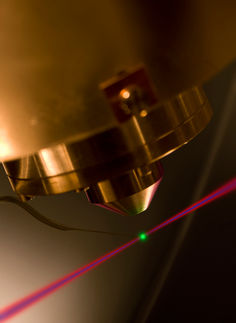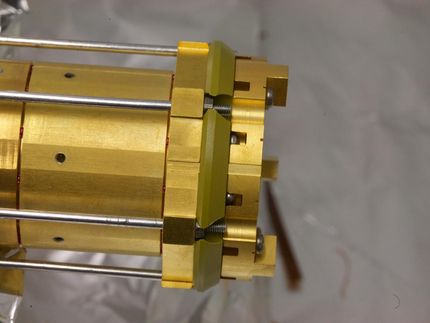Gyroscopes lead scientists to unusual state of matter in a disorganized structure
You don't have to be perfectly organized to pull off a wave, according to University of Chicago scientists.

UChicago scientists crafted a structure that displays unusual waves--which can even be directed into particular shapes.
Noah Mitchell/University of Chicago
Using a set of gyroscopes linked together, physicists explored the behavior of a material whose structure is arranged randomly, instead of an orderly lattice. They found they could set off one-way ripples around the edges, much like spectators in a sports arena--a "topological wave," characteristic of a particularly unusual state of matter.
The discovery offers new insight into the physics of collective motion and could one day have implications for electronics, optics or other technologies.
The team, led by Assoc. Prof. William Irvine, used gyroscopes--the top-like toys you played with as a kid--as a model system to explore physics. Because gyroscopes move in three dimensions, if you connect them with springs and spin them with motors, you can observe all kinds of things about the rules that govern how objects move together.
Two years ago, the team observed an odd behavior in their gyroscopes: at certain frequencies, they could set off a wave that traveled around the edges of the material in one direction only. This was strange, but had some counterparts in other branches of physics. It's a behavior characteristic of a recently discovered state of matter called a topological insulator.
But next, trying to find which conditions were truly essential, they modified the pattern of the gyroscopes. Where before the gyroscopes had been neatly lined up in equally spaced rows, like the lattice pattern in a crystal, Irvine and team scattered the points randomly around.
They turned the gyroscopes on, and still saw the waves.
This is exceedingly strange. Traditionally, the lattice order is very important in physical properties. It's a bit like if every time you tossed a handful of puzzle pieces on the table, it still made a recognizable image.
"Everything up to this point was engineered. We thought you had to build a particular lattice, and that determines where the wave goes," said Irvine. "But when we asked what happened if you took away the spatial order, no crystal plane, no clear structure...the answer's yes. It just works."
"A collective behavior with local roots is also really interesting because that's a much easier way to manufacture a material," said graduate student Noah Mitchell, the first author on the paper. "It was thought spatial order had to be globally coordinated, but the fact that local properties are sufficient could open a lot of possibilities."
There are many materials in the everyday world that don't have a crystalline structure, including Styrofoam, glass, foam, plastic and rubber. The physics behind these systems is less understood than their crystalline counterparts, but as scientists' ability to engineer them--including as quantum systems and metamaterials--grows, they are increasingly of interest. If these amorphous materials could display some of the properties of crystals, it could lay the foundations for new technologies.
Original publication
Other news from the department science

Get the analytics and lab tech industry in your inbox
By submitting this form you agree that LUMITOS AG will send you the newsletter(s) selected above by email. Your data will not be passed on to third parties. Your data will be stored and processed in accordance with our data protection regulations. LUMITOS may contact you by email for the purpose of advertising or market and opinion surveys. You can revoke your consent at any time without giving reasons to LUMITOS AG, Ernst-Augustin-Str. 2, 12489 Berlin, Germany or by e-mail at revoke@lumitos.com with effect for the future. In addition, each email contains a link to unsubscribe from the corresponding newsletter.























































